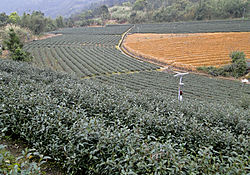Taiwanese tea culture
 From Wikipedia - Reading time: 8 min
From Wikipedia - Reading time: 8 min

Taiwanese tea culture includes tea arts, traditional tea ceremonies, and the social aspects of tea consumption in Taiwan. Its roots can be traced back to Chinese tea culture. Many of the classical arts can be seen in the tea culture, such as calligraphy, flower arts, and incense arts. Tea, especially oolong tea, is a popular drink in Taiwan, and teahouses, or "tea-arts" shops, are common.
History
[edit]The roots of Taiwanese tea culture are Chinese. However, the climate and the landscape have led to the development of a unique tea culture.[1] In particular, development has been spurred by the high mountains.[2]
The island country's tea arts are Chinese that have been influenced by western culture. Gongfu tea ceremony is informally referred to as laoren cha, or "old man tea", which originated in China and has flourished in Taiwan.[citation needed]
Traditionally, emphasis has been placed on single-origin teas, but, in the 21st century, high-quality blended teas gained prominence. Traditional xun tea making, that is, making tea from dried petals or stamens, has also experienced a resurgence.[3]
Tea culture and studies education
[edit]- Tatung Institute of Commerce and Technology
- Lu-Yu Tea Culture Institute
- Tea Research and Extension Station
See also
[edit]- Bubble tea, invented in Taiwan
- Chinese tea culture
- Ding Tea
- Gongfu tea ceremony
- Japanese tea ceremony
- Hong Kong tea culture
- Taiwanese cuisine
- Taiwanese tea
References
[edit]- ^ Kiniry, Laura. "How to Tea-Taste Your Way Through Taiwan". www.smithsonianmag.com. Smithsonian Magazine. Retrieved 2 December 2020.
- ^ Festa, Jessica (28 May 2013). "Sampling Taiwan's Fine High Mountain Tea Culture". epicureandculture.com. Epicure and Culture. Retrieved 2 December 2020.
- ^ "Additive Aesthetic: The Art of Blended Tea". nspp.mofa.gov.tw. MOFA. Retrieved 17 April 2020.
 KSF
KSF